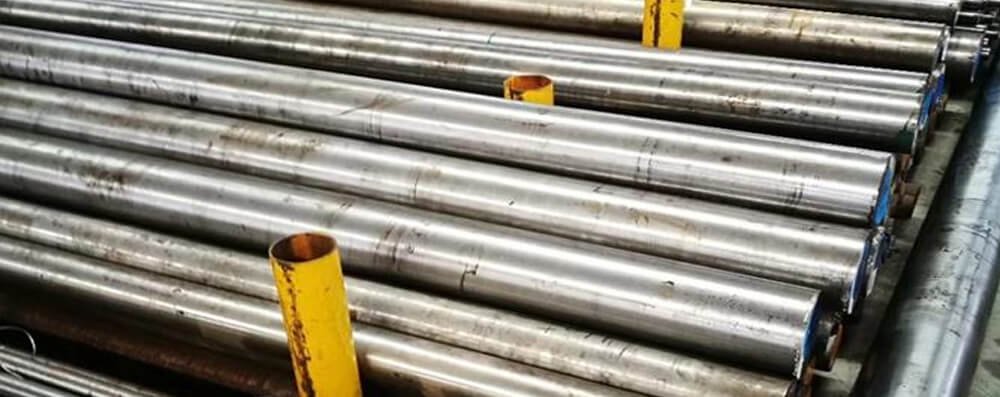Introduction
SAE 8620 is a low-carbon, nickel-chromium-molybdenum alloy steel known for its excellent case hardening properties. After carburizing and heat treatment, it offers a strong, tough core with a hard, wear-resistant surface. This makes it highly suitable for components subjected to high wear and fatigue stresses. It is widely used in the automotive, aerospace, and industrial sectors.
Properties of the Grade:
- Excellent case hardenability
- Good toughness and fatigue strength
- High core strength after heat treatment
- Good ductility and impact resistance
- Excellent machinability in the annealed condition
- Good wear resistance after carburizing
- Good weldability with proper pre- and post-weld treatments
Uses/Applications of the Grade:
- Gears and pinions
- Transmission components
- Shafts and crankshafts
- Camshafts
- Bushings
- Couplings
- Steering parts
- Engine components
- Heavy-duty automotive parts
Chemical Composition:
| Element | Content (%) |
| Carbon (C) | 0.18 – 0.23 |
| Silicon (Si) | 0.15 – 0.35 |
| Manganese (Mn) | 0.70 – 0.90 |
| Phosphorus (P) | ≤ 0.035 |
| Sulfur (S) | ≤ 0.040 |
| Chromium (Cr) | 0.40 – 0.60 |
| Nickel (Ni) | 0.40 – 0.70 |
| Molybdenum (Mo) | 0.15 – 0.25 |
Mechanical Properties:
(After Carburizing and Hardening)
| Property | Typical Value |
| Tensile Strength | 850 – 1100 MPa |
| Yield Strength | 550 – 700 MPa |
| Elongation | ≥ 12% |
| Impact Toughness (ISO V-notch) | ≥ 45 J |
| Surface Hardness (after Case Hardening) | 58 – 62 HRC |
| Core Hardness | 30 – 45 HRC |
Physical Properties:
| Property | Typical Value |
| Density | 7.85 g/cm³ |
| Modulus of Elasticity | 210 GPa |
| Thermal Conductivity | ~ 46 W/m·K |
| Specific Heat Capacity | ~ 460 J/kg·K |
| Coefficient of Thermal Expansion | ~ 12.3 × 10⁻⁶ /°C |
Forging:
Forging Temperature Range: 850°C – 1150°C
Forging Procedure:
- Uniformly heat to 1150°C.
- Forge down to 850°C.
- Cool slowly in a furnace or dry ashes to prevent cracking.
Heat Treatment:
-
Annealing:
- Heat to 820°C – 850°C.
- Slow furnace cooling to improve machinability.
-
Carburizing:
- Carburize at 880°C – 950°C for required case depth.
-
Hardening:
- Post-carburizing, reheat to 820°C – 840°C.
- Quench in oil or water as necessary.
-
Tempering:
- Temper at 150°C – 200°C to achieve the desired balance between hardness and toughness.
Dimensional Tolerances:
- Hot Rolled Bars: As per EN 10060 standard tolerances.
- Bright Drawn Bars: Tolerances according to ISO h9/h11 standards.
- Ground Bars: Available with precision tolerances up to ISO h6.
Machinability:
- Good machinability in annealed condition (~65% machinability relative to B1112).
- Use high-speed steel or carbide tools for optimum performance.
- Adequate lubrication and cooling are important to prolong tool life.
Corrosion Resistance:
- Moderate corrosion resistance.
- Not suitable for marine or highly corrosive environments without surface treatment.
- Protective coatings like zinc plating or phosphating are recommended for better durability.
Weldability:
Weldable with proper precautions:
- Preheat to 200°C – 300°C.
- Post-weld heat treatment is advisable to restore mechanical properties.
- Low-hydrogen welding processes (TIG, MIG) are preferable.
Available Form:
SAE 8620 is available in:
- Hot Rolled Round Bars
- Bright Drawn Bars
- Forged Bars
- Peeled and Ground Bars
- Cut-to-size Blocks
- Supplied in annealed or hardened and tempered conditions
Conclusion:
SAE 8620 Alloy Steel Bar offers a unique blend of high toughness, strength, and excellent case hardenability. These properties make it an ideal choice for manufacturing high-strength mechanical components that demand a tough, fatigue-resistant core with a hard, wear-resistant outer layer. Its ease of machinability and good weldability (with proper techniques) further enhance its appeal across a wide range of demanding engineering and automotive applications.
Related Products : 16MnCr5, EN19, 42CrMo4, 20MnCr5, EN353, EN31, EN24, EN47, EN41B, SAE4140, SAE52100, SAE 8620, SCM420, EN36C, Maps


